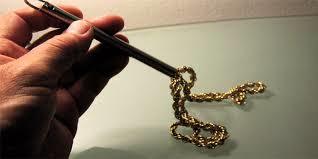- How to Choose a Petticoat and Slip for Your Wedding Dress - May 24, 2023
- Your Pink Diamond Buying Guide - April 23, 2023
- Where To Get The Best Asscher Cut With Tapered Baguette Diamonds - April 23, 2023
While you might be sure that the gold you buy from a reputable jeweler is real, there are other times where it might not be so apparent. Gold collectors are always finding gold that they need to test to be sure it’s real.
These collectors work with fake gold all the time, so they’re adept at being able to tell the real gold from the fake gold.
When you’re a collector, you have to be able to tell visually whether the gold is real or not.
While it’s not an exact science, when you’re in the business of buying and selling old pieces, it’s easy to become adept at visually inspecting the gold for the real thing.
Clues That the Gold Might Not be Real and How to Tell if it’s Real Gold
Experts can identify when the metal is suspicious by certain details on the piece itself. It’s like when a fashion-conscious shopper can tell that a Gucci purse isn’t the real deal. It’s in the small details most of the time.
For the Gucci purse, it might show in the stitching or the branding that it’s not by the real designer. For gold jewelry, it’s in details like only one stamp that says 14k or when O-rings aren’t soldered because it would melt the fake piece.
Fake gold has the following characteristics:
- Shiny, brass-like gold alloy features
- One 14k stamp
- O-rings are not soldered
- Base metal is showing (doesn’t appear to be pure gold)
- Post in the earrings is worn to metal
- Shank of a ring shows wear
- Stamps will be HGP or HEG, which is Heavy Gold Plate or Heavy Electro-Gold Plate
- Could be stamped with GF, or gold-filled
Fake Gold Visual Inspection
How to Test Gold Jewelry
It’s not always possible for collectors to test their gold pieces immediately, so they’ll make an educated guess based on the features above.
They might take a chance on buying a potential fake piece of gold if there’s a question about it authenticity but it’s a reasonably priced item. Their knowledge can help you figure out whether the gold you have is real or fake, too.
Magnet Test: Fake vs Real Gold
While pure gold isn’t magnetic, the metals used for fake gold are. You should be able to hold a magnet next to your gold jewelry without the piece being attached to the magnet. Test it out on pieces you know are absolutely 14k or 18k gold.
You’ll see that these pieces won’t react to the magnet. If you hold the magnet near other metals, the magnet will attract them. Unfortunately, this isn’t a definitive test since some jewelry might not be pure gold, but it’s not made of metal.

Skin Discoloration
If you wear the jewelry, whether it’s a bangle bracelet or a ring, and it turns your skin green or black, that’s a huge red flag. Unless you have a specific allergy to gold or a reaction to hand soap or lotion, it’s likely that your skin turned green or black due to the metal not being a true gold. The metal will mix with the oil and sweat from your skin and discolor the skin.
Click here for gold rings that won’t turn your finger green!
Floating Ring
For this test, all you need is a cup of water. Metal other than gold will hover slightly in the water while gold itself will sink to the bottom. Another way to test is to use a vial that has millimeter markings on the side.
When you place gold in the vial, it’ll displace a certain amount of water based on its weight. This can be incredibly complicated, though. You might want to bring the gold to a professional who can do certain tests on it instead.

Ceramic Test
With an unglazed piece of ceramic, you can lightly scrub the jewelry across it. If the jewelry is gold, a light gold streak will have rubbed on the ceramic. Another metal will leave a black mark on the ceramic instead. If you don’t have any ceramic, unglazed plates, you can easily pick one up in an arts and crafts store or home improvement store.
Acid Test
Once of the best ways to test to see if something is real gold is to do an acid test. This involves buying nitric acid and placing your jewelry in a stainless steel bowl. When the acid hits the jewelry, the reaction will let you know whether it’s real gold or fake. If the reaction is green, the jewelry is brass. If it’s milky, the metal is gold plated jewelry. Only if there’s no reaction would the jewelry be real gold.
Final Take: How to Tell if Gold Jewelry is Real
If you’re unsure, or don’t want to rely on tests that are unfamiliar, you can bring your jewelry to a professional who can do any of these tests for you.
It will likely cost you some money for a reputable jeweler to test the jewelry that you think might be gold, but it’ll be worth it if you are trying to decide whether to sell it.
